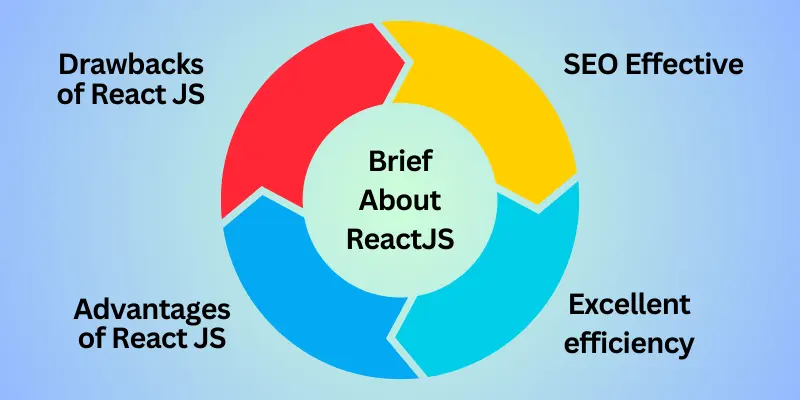Choosing the appropriate technology stack is crucial in the constantly changing digital world of web design. This is why AngularJS, NodeJS, and ReactJS are the most popular players widely used by web application Development Companies.
AngularJS provides structured front-end solutions, whereas NodeJS revolutionizes server-side capabilities, and ReactJS provides a declarative approach.
Application success depends on the approach of each app's creator, which helps in choosing the appropriate framework. In this blog post, we compare AngularJS, NodeJS, and ReactJs in detail. If you're confused about any of them, this guide will clarify all your doubts.
JavaScript supports various frameworks, but we will discuss only the most effective and top three frameworks: Angular JS, Node JS, and React JS.
The differences between Angular, Node, and React help businesses, owners, and developers select the best framework for web application development. AngularJS Developer Tools fuel this battle. The most beneficial aspect of the JS framework is that it improves your online presence and enhances your brand's image.
So, experts in various forums discuss Angular against React and Node. Let's explore each framework in depth now.
React vs. Angular vs Node: A feature-based comparison.
The comparison below is based on Google trends regarding various factors that impact the performance of these three frameworks: Angular, React, and Node.
Popularity
According to a study published by NPM, the trends report, React JS has hit more than 500,000 downloads from developers compared with Node JS and Angular JS, while Node JS has below 100,000 hits, and Angular has reached 100,000 downloads.
However, it doesn't mean that, among Angular against Node vs React, React is the most effective. You should read/ research more and more and make informed decisions accordingly.
Performance
The speed of performance is an essential aspect of web application development. Particularly if you wanted to know which is better, Node vs. React or the Angular framework. It is worth mentioning that DOM is considered to be an essential element in the user interface of any web or mobile application.
AngularJS has several features that can slow down the speed performance of your application, especially when dealing with large applications. Compared with other frameworks, i.e., React and Node, Angular is slightly slow in performance.
While React JS gives developers a high-level learning curve and the freedom to adjust features or options according to their preferences, at times, they might not be able to operate comfortably using it. However, implementing new features is smooth, and applications based on React JS perform better than Angular or Node.
Node JS does not get many votes from the community for performance, but it uses virtual DOM to allocate memory and improve performance. It also includes nearly all the features React and Angular have.
Migration
Migration is the process of adapting developers to the latest version of frameworks. If you compare Node against Angular and React, Node takes the easiest approach to update and renders remarkable flexibility for developers.
In AngularJS Web Development, the technical staff is regularly subject to two rounds of updates. The first update occurs every six months, and the following months are for APIs that have been depreciated, if any.
React JS is far closer to updating than Node JS or Angular JS. It offers a seamless transition from the current version to the newest version with a steady flow.
Node JS provides a quick migration tool that allows React JS developers to adapt to the latest version of Node JS quickly since nearly 90 percent of APIs don't require any modifications.
Learning Curve
When analyzing the learning curve between Node, React, and Angular. Node secures the first post regarding user-friendliness, whereas React comes in second, and Angular comes in third Angular.
Framework Size
If you want to create lightweight apps, you can choose between React or Node. For large-scale applications, AngularJS is the right option. However, the file dimensions of Angular, React, and Node are 50areB, 100KB, and 80KB, respectively.
Development Speed
The development speed depends on the quantity of libraries accessible to committed developers from Nodejs.
Angular offers an excellent platform for deploying speed since it comes with more libraries than React; however, it is also a great platform for deploying applications. React JS architecture is highly flexible compared to Angular, and, unlike Node JS, both are achievable without any effort.
Community Support
Similarly, Google maintains AngularJS, and Facebook manages ReactJS. Both have huge support from the community, while Node JS, being an open-source community at present, will require some time to gain recognition.
AngularJS
Your list of tasks should include selecting a reputable company that offers an application monitoring tool. Web applications are susceptible to certain problems, like mistakes or blog posts, that could negatively affect performance and the effort put into developing them. Still, if you have some doubts, you can seek suggestions from an AngularJS development company, as they will help you make the right decision.
Therefore, it is essential to create a robust monitoring and management system before anything else. Here are a few excellent tools you can use for the use of Node.JS:
-
-
Monitis
-
Newrelic
-
LogicMonitor
-
Ruxic
-
Stackify
-
These tools can identify and eliminate any obstruction to your application's speed by providing extensive data and a detailed record of activity patterns. In simple words, these live performance assessment tools allow for a more intelligent analysis.
Look Deeper
Be aware that the root of the issue, not just the symptoms, should be considered when trying to speed up Node.js code. It could be that you're running an underpowered machine, a glitch inside the source code, or an automated scaling that has yet to be implemented.
Prioritize the issue so you can investigate and decide what next steps to take. Be sure to keep note of the program's behavior, as this will help you identify the problem.
Also Read: What You Need to Know About AngularJS Development Tools in 2024
Brief About AngularJS
AngularJS is a highly dynamic JavaScript framework created by Google that changed the face of the front end of Web development. With its powerful data binding in two directions and modular design that allows developers to develop innovative single-page websites (SPAs) that provide seamless user experience. AngularJS simplifies complicated tasks, manipulating data and rendering gracefully. The declarative design makes it easier to manage code maintenance, which makes it an ideal option for large-scale projects.
Advantages of AngularJS
-
-
Framework that is easy to test
-
The synchronization of data is performed automatically between the model and the component's view
-
Vast Angular libraries
-
Inbuilt dependency injection subsystem
-
Simple route
-
Binding of Angular Data
-
Marvelous UI design
-
A custom-designed document object model can be created quickly
-
It offers a strong template upon which mob app to build.
-
Disadvantages of using Angular JS
-
-
Performance issues accompany DOM elements
-
Limited routes are offered
-
Scopes can be difficult to identify
-
Angular is slow when pages contain interactive elements.
-
Third-party integration can be extremely complicated.
-
The learning curve is steep.
-
Brief About ReactJS

ReactJS is the JavaScript library created by Facebook. It is focused on creating user interfaces using an architecture based on components. Its virtual DOM can efficiently update only the required elements of a website page, which results in improved speed and more fluid user interaction. ReactJS's popularity is partly due to its ability to make reusable UI components, which simplify the web app development process and encourage code reuse.
SEO Effective
ReactJS can be run easily on a server. After that, a DOM virtualization will get back to the browser as a webpage. This is advantageous because search engines have difficulty comprehending JS-heavy applications, a significant problem for JS frameworks.
Excellent efficiency
ReactJS creates the virtual DOM and handles all changes to it and any changes to the DOM tree. It's a fantastic and flexible method for getting the best performance.
Advantages of React JS
-
-
It provides quicker updates.
-
Importing components is fairly simple
-
With ReactJS, you can reuse the same code
-
JS debugging is a breeze.
-
It comes with an easy API for learning and a smooth interface design
-
A fully component-based architecture
-
Drawbacks of React JS
-
-
The learning curve is steep.
-
It's not an entire framework but an application library
-
Flux architectures
-
A few configurations will be required if you decide to integrate React within or into an MVC framework.
-
Also Read: Frontend Web Development: How To Develop Application Using React JS
Brief About NodeJS

NodeJS, a runtime platform powered by Chrome's V8 JavaScript engine, is bringing the server side of JavaScript into the limelight. It's a game changer for real-time apps, allowing developers to build server-side logic using JavaScript. Its event-driven structure guarantees high scalability and rapid response, making it a top choice for chat and online gaming applications.
Server-side proxy
NodeJS can handle multiple simultaneous connections without causing blockages because it acts as a server-side proxy. It is most often utilized for proxying various services that have different response times.
NPM
NPM(Node Package Manager) is included as a default feature of the Node.js installation and offers support for managing packages. The concept behind NPM is very similar with Ruby Gems. The most widely utilized NPM modules include:
-
-
Mongojs and MongoDB
-
Connect
-
Moment
-
bluebird
-
Pug
-
socket.io and the sockjs
-
Advantages of NodeJS
-
-
The same code is used by both servers and clients
-
Large files can be easily streamed
-
NPM is already deep and is rising at a rapid pace
-
Easy to learn
-
A large community of support
-
Drawbacks of Node JS
-
-
Insufficiently scalable, as one CPU isn't sufficient to handle many tasks
-
A comprehension of JavaScript is essential for working with NodeJS
-
Problems with relational databases
-
The best choice for web servers but not designed for high-end CPU tasks
-
Nested callbacks
-
Conclusion
Angular JS, React JS and Node JS are top-performing frameworks that support efficient app development. Based on your app's requirements, you must decide which one best fits them.
In comparison to ReactJS's advancement, AngularJS is fully featured because React JS is not even an actual framework but rather an application library. However, regarding speed, React stands out more than Angular due to its virtual DOM. Therefore, it constantly changes in accordance with specific parameters. ,
Hoping that the guide will help you in choosing the best framework according to your specific requirements.













Share this blog